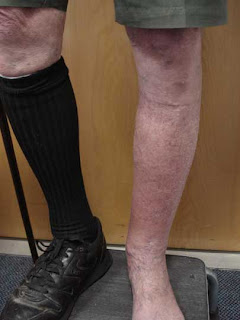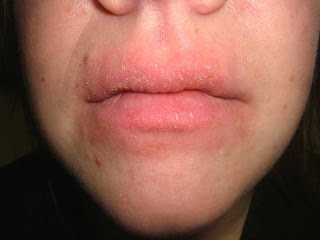Presented by Professor Khalifa Sharquie
Baghdad, Iraq
History: A few weeks ago, an outbreak of thallium poisoning occurred in Baghdad and all of the patients had positive tests for thallium. We had the opportunity to see cases with skin manifestations. All patients gave a history of eating cakes and presented to hospital with nausea, vomiting followed by mental and peripheral neurological complaints. The case I am presenting was that of a 30 yo adult male referred to me two weeks after poisoning. He had severe hair loss, both diffuse and patchy, affecting mainly scalp and body hair. Also he had a non-pruritic rash affecting the face, limbs and groins.
O/E: The striking findings were severe anagen hair loss, diffuse and in patches. The hairs were easily plucked and microscopically were typical anagen phase. The next important finding was dermatitis-like picture that covered the face especially around the mouth and the limbs mainly on the dorsae of both hands. The groins had intertrigo simulating tinea cruris. The rash was dusky red and ecchymotic in appearance.
Photographs:
This picture was strange enough to make one think about the following Differential Diagnosis:
Acquired zinc deficiency
Pellagra
Erythema multiforme
But only suspicion can lead you into right diagnosis. Accordingly, before the definite diagnosis was established, we gave oral zinc sulfate 100mg 3 times a day for some patients. Surprisingly they recovered and resolved.
Reason Presented: Thallium is nice rat poison since it is colorless, tasteless and odourless. It can be used as massive lethal chemical weapon and is practiced this way in Iraq as a way to kill people. It is my opinion that thallium should be prohibited and considered as a chemical weapon like nitrogen mustard. It is better to let rats run free than to kill human beings.
Reference: A good article on this subject appeared in the Archives of Dermatology in January, 2007. Short-term thallium intoxication: dermatological findings correlated with thallium concentration.
Arch Dermatol. 2007 Jan;143(1):93-8.
Lu CI, Huang CC, Chang YC, Tsai YT, Kuo HC, Chuang YH, Shih TS.
Department of Dermatology, Chang Gung Memorial Hospital, Taipei, Taiwan.
One can view this free online: Arch Dermatol article
Comment: John Donne wrote: "All mankind is of one author, and is one volume; when one man dies, one chapter is not torn out of the book, but translated into a better language; and every chapter must be so translated....No man is an island, entire of itself...any man's death diminishes me, because I am involved in mankind; and therefore never send to know for whom the bell tolls; it tolls for thee."
Our Western civilization began in the Fertile Crescent. Iraq was at the epicenter. The strory told here diminishes all of us. Professor Sharquie bravely bears witness as he helps and serves his people.











